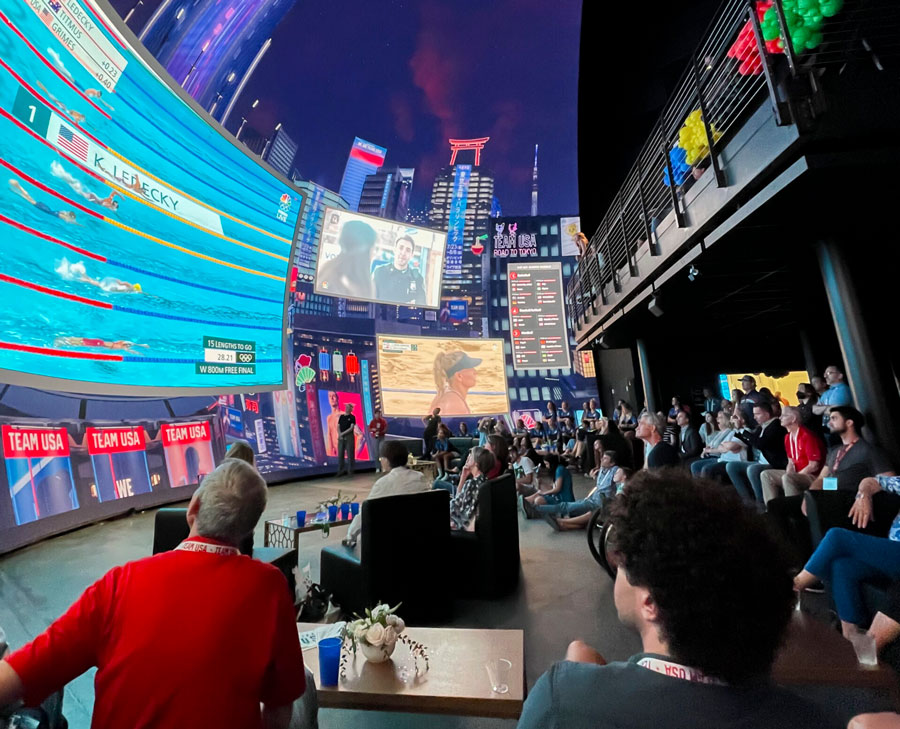
Unlike traditional static signage, interactive displays offer flexibility through customizable content and interactive features such as touch screens, gesture controls, and motion sensors. New technologies now help you create immersive and memorable interactions that cater to the modern consumer’s expectations for customization and engagement.
This blog post will explore interactive display ideas and use cases to understand how businesses can use interactive displays for immersive experiences, streamlined communications, and dynamic event engagements.
Brief Introduction to Interactive Displays
Interactive displays, also known as interactive panels, are screens that allow users to interact in real time with digital content. They use built-in sensors to detect the user’s touch, actions, gestures, facial emotions, voice, and sound and then convert them into actionable commands that produce visible responses on the screen.
These advanced screens are gaining popularity in educational and business environments due to their ability to foster collaboration and engagement.
They have various purposes, including business presentations, interactive customer support like maps and wayfinding, experiential marketing, and educational tools.
Also, they are common in exhibitions to show products and services.
According to Fortune Business Insights, the education sector is the largest market segment for interactive displays. This segment is driven by the increasing adoption of digital learning tools.
It is expected to continue growing as more educational institutions integrate these technologies into their curricula.
For instance, Thomas Moeller’s “Michelin Dealership Touchscreen” project integrated digital touchscreen interfaces to enhance the purchasing process. It aimed to educate consumers about Michelin products and services in an interactive and informative manner.
This approach benefits larger dealerships, providing detailed, easily accessible information such as tire comparisons, performance metrics, and personalized recommendations. Michelin collaborates with dealerships globally to improve customer experience through these innovative digital solutions.

A comprehensive interactive screen experience has two key components: hardware and visual content.
The hardware includes diverse types of touchscreens – such as wall-mounted displays, touch-tables, stand-mounted setups, and custom-built enclosures – each powered by PCs that manage the visual content users interact with.
This inclusive technology caters to a wide range of users and business needs. It enables you to:
- Capture Leads: Gather potential customer information directly through the touchscreen.
- Educate Customers: Provide interactive educational content about your products or services.
- Product Exploration: Allow customers to explore your product range in-store or at a trade counter.
- Sales Support: Facilitate sales conversations and enhance customer interactions.
- Promotions: Promote new product launches or special offers effectively.
- Create Memorable Experiences: Develop engaging interactions that leave a lasting impression on users.
Using interactive displays strategically can enhance customer engagement, streamline operations, and create impactful brand experiences. This approach improves overall efficiency and boosts visibility and engagement. Now, let’s explore top-notch interactive display ideas and use cases.
Interactive Displays Ideas and Use Cases
Interactive displays offer limitless possibilities for engaging your audience and enhancing various environments.
Whether you’re in retail, events, education, or corporate settings, incorporating interactive display technology can transform how you communicate and interact with your customers, visitors, or employees.
Social Media Integrated Interactive Displays
Interactive flat panels at events integrate seamlessly with social media platforms, like Twitter, Instagram, and Facebook. Attendees can share live updates, photos, and thoughts instantly, creating a sense of community and interaction. Event organizers curate and display user-generated content in real-time on social media walls, enhancing engagement and making the event more dynamic and interactive.

Immersive Sports Viewing
Interactive displays in sports venues offer fans real-time statistics, player profiles, and interactive elements like trivia and predictive challenges. These screens enrich the fan experience by providing deeper insights into the game and creating opportunities for engagement during breaks and downtime.

Live Streaming Interactive Screens
Events and conferences can reach a global audience through interactive displays equipped with live-streaming capabilities. Virtual attendees can participate in live sessions, ask questions, and interact with speakers or performers in real-time, bridging geographical barriers and increasing event accessibility.

Interactive Local Information Displays
Interactive displays in public spaces like hospitals, schools, and shopping malls provide up-to-date local news, weather updates, and curated RSS feeds. Users can access relevant information conveniently, enhancing their experience and informing them in real-time.

Interactive Corporate Communication
Within corporate settings, interactive displays serve as digital bulletin boards for showcasing company updates, employee achievements, and important announcements. Employees can interact with displayed content, providing feedback and fostering a transparent communication culture across departments.
Interactive Creative Expression and Digital Art
Interactive displays in retail centers and cultural venues offer visitors opportunities for creative expression. Activities such as touchscreen painting, collage making, and interactive music creation engage users creatively, providing a memorable and immersive experience beyond traditional art forms.
Interactive Navigation and Wayfinding Digital Signage
Maps and directories on interactive screens assist visitors in navigating complex environments such as events, campuses, and shopping centers. Users can easily locate points of interest, find directions, and explore interactive features that enhance their overall navigation experience.
Interactive Floor/Wall Games
Ideal for venues like museums, shopping malls, and entertainment centers, interactive wall and floor games offer a dynamic platform for users of all ages to interact with virtual environments. These installations promote teamwork, interactive learning, and problem-solving skills in an entertaining and immersive manner.
With customizable game options and responsive technology, they create memorable experiences that blend physical play with digital innovation, making them popular attractions in interactive entertainment spaces worldwide.
Interactive Augmented Reality Experiences
Retail stores and entertainment venues leverage augmented reality (AR) on interactive displays to enhance customer engagement. AR features allow users to interact with virtual elements overlaid on physical spaces, creating immersive and personalized experiences aimed at enhancing customer satisfaction and loyalty.
Personalized Interactions via Facial Recognition
Interactive displays equipped with facial recognition technology offer personalized interactions in retail and hospitality settings. Features like virtual try-ons, personalized recommendations, and interactive games enhance customer engagement by catering to individual preferences and behaviors.
Sensory and Relaxation Experiences
Interactive displays provide sensory experiences through calming visuals, ambient sounds, and guided meditations. These installations are used in corporate wellness programs, healthcare settings, and educational environments to promote relaxation, reduce stress, and enhance overall well-being.
Interactive Exhibit Flat Panels
Educational exhibits, marketing campaigns, and corporate presentations use LED displays with touch-sensitive surfaces and motion-tracking technology to create vibrant and interactive storytelling experiences. These interactive flat panels captivate audiences by allowing them to interact directly with displayed content, enhancing engagement and communication effectiveness.
Interactive Selfie Walls
Events, retail spaces, and promotional campaigns feature interactive selfie walls equipped with LED lights, projection mapping, and interactive elements. These interactive displays provide visually engaging backgrounds for photos and videos, encouraging user-generated content that enhances brand exposure and social media engagement.
Interactive AR Murals
For street artists, interactive augmented reality murals offer a powerful new way to showcase your talent and reach a broader audience. By integrating augmented reality technology into your artwork, viewers can interact with animations, videos, and games directly from their smartphones, transforming static murals into dynamic, engaging experiences.
These murals benefit both brands and street artists alike. They offer memorable and engaging experiences for viewers, spark social media buzz, and serve as dynamic platforms for creative expression. So, businesses and artists can deliver immersive experiences that leave a lasting impression.
AI-Powered Personalized Experiences
Advancements in artificial intelligence (AI) and sensor technologies allow displays to react dynamically to viewers, adapting content based on their movements, physical characteristics like height and age, and even emotional cues. This innovation transforms how businesses engage with audiences, offering personalized experiences that are both compelling and memorable.
AI-powered interactive screens are particularly effective in trade shows, conferences, and educational settings where engaging with diverse audiences is crucial. By customizing content to match individual preferences and demographics in real-time, businesses can capture attention, deliver targeted messages, and collect valuable data on user interactions. This enhances visitor engagement and provides insights to optimize marketing strategies and improve overall customer experiences.
These descriptions show how the features of interactive displays are continuously evolving, enhancing engagement, interaction, and user experience across various sectors, from entertainment and education to retail and corporate environments. Interactive display ideas and use cases will evolve and adapt to new technologies and changing user expectations.
Transform Your Interactive Displays with Our Innovative Solutions
At Dream Farm Agency, we take your interactive media ideas to the next level. Our interactive design service brings concepts to life, making them easily understandable and visually striking.
Contact us today for a consultation or to learn more about how we can enhance your interactive media projects.

Fareena



